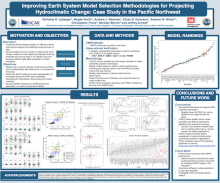Improving Methodologies for Earth System Model Selection for Hydrometeorological Climate Change Impact Applications over the Pacific Northwest
Nicholas
Lybarger
NCAR/RAL
Poster
The rapid expansion of Earth system model (ESM) data available from the Coupled Model Intercomparison Project Phase 6 (CMIP6) necessitates new methods to evaluate the performance and suitability of ESMs used for hydroclimate applications as these extremely large data volumes complicate stakeholder efforts to use new ESM outputs in updated climate vulnerability and impact assessments. We develop an analysis framework to inform ESM sub-selection based on process-oriented considerations and demonstrate its performance for a regional application in the US Pacific Northwest. First, a suite of global and regional metrics is calculated, using multiple historical observation datasets to assess ESM performance. These metrics are then used to rank CMIP6 models, and a culled ensemble of models is selected using a trend-related diagnostics approach. This culling strategy does not dramatically change climate scenario trend projections in this region, despite retaining only 20% of the CMIP6 ESMs in the final model ensemble. The reliability of the culled trend projection envelope and model response similarity is also assessed using a perfect model framework. The absolute difference in temperature trend projections is reduced relative to the full ensemble compared to the model for each SSP scenario, while precipitation trend errors are largely unaffected. In addition, we find that the spread of the culled ensemble temperature and precipitation trends includes the trend of the “truth” model ~83-92% of the time. This analysis demonstrates a reliable method to reduce ESM ensemble size that can ease use of ESMs for creating and understanding climate vulnerability and impact assessments.

Poster file
lybarger-nicholas-confronting-poster.pdf
(2.11 MB)
